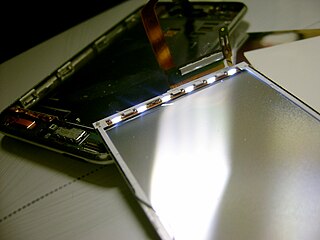
Flat-panel displays are electronic viewing technologies used to enable people to see content (still images, moving images, text, or other visual material) in a range of entertainment, consumer electronics, personal computer, and mobile devices, and many types of medical, transportation and industrial equipment. They are far lighter and thinner than traditional cathode ray tube (CRT) television sets and video displays and are usually less than 10 centimetres (3.9 in) thick. Flat-panel displays can be divided into two display device categories: volatile and static. Volatile displays require that pixels be periodically electronically refreshed to retain their state (e.g., liquid-crystal displays (LCD)). A volatile display only shows an image when it has battery or AC mains power. Static flat-panel displays rely on materials whose color states are bistable (e.g., e-book reader tablets from Sony), and as such, flat-panel displays retain the text or images on the screen even when the power is off. As of 2016, flat-panel displays have almost completely replaced old CRT displays. In many 2010-era applications, specifically small portable devices such as laptops, mobile phones, smartphones, digital cameras, camcorders, point-and-shoot cameras, and pocket video cameras, any display disadvantages of flat-panels (as compared with CRTs) are made up for by portability advantages (thinness and lightweightness).
An electronic visual display, informally a screen, is a display device for presentation of images, text, or video transmitted electronically, without producing a permanent record. Electronic visual displays include television sets, computer monitors, and digital signage. By the above definition, an overhead projector could reasonably be considered an electronic visual display since it is a display device for the presentation of an images, plain text, or video transmitted electronically without producing a permanent record. They are also ubiquitous in mobile computing applications like tablet computers, smartphones, and information appliances.

An image is an artifact that depicts visual perception, such as a photograph or other two-dimensional picture, that resembles a subject—usually a physical object—and thus provides a depiction of it. In the context of signal processing, an image is a distributed amplitude of color(s).

Video is an electronic medium for the recording, copying, playback, broadcasting, and display of moving visual media. Video was first developed for mechanical television systems, which were quickly replaced by cathode ray tube (CRT) systems which were later replaced by flat panel displays of several types.
Contents
- History
- Common types
- Liquid crystal displays
- Liquid crystal displays with light-emitting diode (LED) backlighting
- Plasma panels
- Electroluminescent panels
- Organic light-emitting diode
- Quantum dot light emitting diode
- Volatile
- Examples
- Static
- See also
- References
- External links
Most 2010s-era flat-panel displays use LCD and/or LED technologies. Most LCD screens are back-lit as color filters are used to display colors. Flat-panel displays are thin and lightweight and provide better linearity and they are capable of higher resolution than typical consumer-grade TVs from earlier eras. The highest resolution for consumer-grade CRT TVs was 1080i; in contrast, many flat-panels can display 1080p or even 4K resolution. As of 2016, some devices that use flat-panels, such as tablet computers, smartphones and, less commonly, laptops, use touchscreens, a feature that enables users to select onscreen icons or trigger actions (e.g., playing a digital video) by touching the screen. Many touchscreen-enabled devices can display a virtual QWERTY or numeric keyboard on the screen, to enable the user to type words or numbers.

A backlight is a form of illumination used in liquid crystal displays (LCDs). As LCDs do not produce light by themselves—unlike, for example, cathode ray tube (CRT) displays—they need illumination to produce a visible image. Backlights illuminate the LCD from the side or back of the display panel, unlike frontlights, which are placed in front of the LCD. Backlights are used in small displays to increase readability in low light conditions such as in wristwatches, and are used in smart phones, computer displays and LCD televisions to produce light in a manner similar to a CRT display. A review of some early backlighting schemes for LCDs is given in a report Engineering and Technology History by Peter J. Wild.
1080i is an abbreviation referring to a combination of frame resolution and scan type, used in high-definition television (HDTV) and high-definition video. The number "1080" refers to the number of horizontal lines on the screen. The "i" is an abbreviation for "interlaced"; this indicates that only the odd lines, then the even lines of each frame are drawn alternately, so that only half the number of actual image frames are used to produce video. A related display resolution is 1080p, which also has 1080 lines of resolution; the "p" refers to progressive scan, which indicates that the lines of resolution for each frame are "drawn" in on the screen sequence.

1080p is a set of HDTV high-definition video modes characterized by 1,920 pixels displayed across the screen horizontally and 1,080 pixels down the screen vertically; the p stands for progressive scan, i.e. non-interlaced. The term usually assumes a widescreen aspect ratio of 16:9, implying a resolution of 2.1 megapixels. It is often marketed as full HD, to contrast 1080p with 720p resolution screens.
A multifunctional monitor (MFM) is a flat-panel display that has additional video inputs (more than a typical LCD monitor) and is designed to be used with a variety of external video sources, such as VGA input, HDMI input from a VHS VCR or video game console and, in some cases, a USB input or card reader for viewing digital photos). In many instances, an MFM also includes a TV tuner, making it similar to a LCD TV that offers computer connectivity.

HDMI is a proprietary audio/video interface for transmitting uncompressed video data and compressed or uncompressed digital audio data from an HDMI-compliant source device, such as a display controller, to a compatible computer monitor, video projector, digital television, or digital audio device. HDMI is a digital replacement for analog video standards.
A video game console is a computer device that outputs a video signal or visual image to display a video game that one or more people can play.

USB is an industry standard that establishes specifications for cables, connectors and protocols for connection, communication and power supply between personal computers and their peripheral devices. Released in 1996, the USB standard is currently maintained by the USB Implementers Forum. There have been three generations of USB specifications: USB 1.x, USB 2.0 and USB 3.x; the fourth called USB4 is scheduled to be published in the middle of 2019.
















